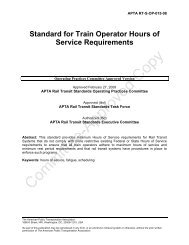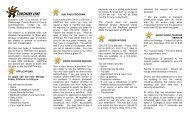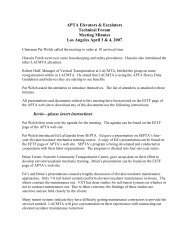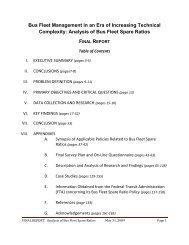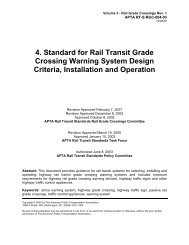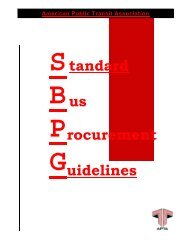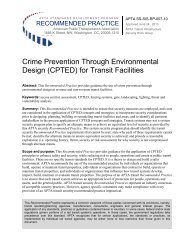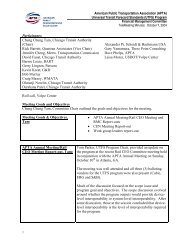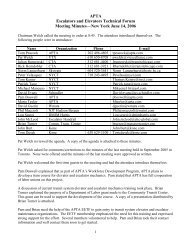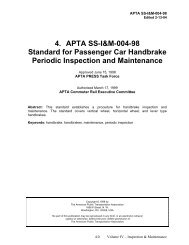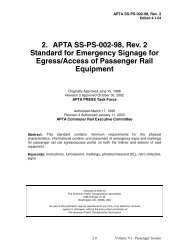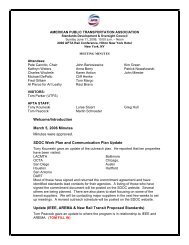APTA RT-S-VIM-017-03 - APTAStandards.com
APTA RT-S-VIM-017-03 - APTAStandards.com
APTA RT-S-VIM-017-03 - APTAStandards.com
You also want an ePaper? Increase the reach of your titles
YUMPU automatically turns print PDFs into web optimized ePapers that Google loves.
Copyright © 2004 by The American Public Transportation Association<br />
1666 K Street, NW, Washington, DC, 20006-1215, USA<br />
Volume 2 - Vehicle Inspection and Maintenance<br />
<strong>APTA</strong> <strong>RT</strong>-S-<strong>VIM</strong>-<strong>017</strong>-<strong>03</strong>, Rev. 1<br />
08/29/06<br />
17. Standard for the Calibration of<br />
Inspection and Maintenance Precision<br />
Measuring Devices and Tools<br />
Originally Approved January 14, 20<strong>03</strong><br />
Revision 1 Approved insert date<br />
<strong>APTA</strong> Rail Transit Standards Vehicle Inspection and Maintenance Committee<br />
Originally Approved May 23, 20<strong>03</strong><br />
Revision 1 Approved insert date<br />
<strong>APTA</strong> Rail Transit Standards Task Force<br />
Originally Authorized September 28, 20<strong>03</strong><br />
Revision 1 Authorized insert date<br />
<strong>APTA</strong> Rail Transit Standards Executive Committee<br />
Abstract: This standard covers basic procedures for calibration of inspection and maintenance<br />
precision measuring devices and tools.<br />
Keywords: calibration, precision measuring device, tools.<br />
No part of this publication may be reproduced in any form, in an electronic retrieval system or otherwise, without the prior written<br />
permission of The American Public Transportation Association.
Introduction<br />
Volume 2 - Vehicle Inspection and Maintenance<br />
<strong>APTA</strong> <strong>RT</strong>-S-<strong>VIM</strong>-<strong>017</strong>-<strong>03</strong>, Rev. 1<br />
08/29/06<br />
(This introduction is not part of <strong>APTA</strong> <strong>RT</strong>-S-<strong>VIM</strong>-<strong>017</strong>-<strong>03</strong>, Standard for the Calibration of Inspection and<br />
Maintenance Precision Measuring Devices and Tools)<br />
This Standard for the Calibration of Inspection and Maintenance Precision Measuring Devices<br />
and Tools for rail transit vehicles represents a <strong>com</strong>mon viewpoint of those parties concerned<br />
with its provisions, namely, transit operating/planning agencies, manufacturers, consultants,<br />
engineers and general interest groups. The application of any standards, practices or guidelines<br />
contained herein is voluntary. In some cases, federal and/or state regulations govern portions of<br />
a rail transit system’s operations. In those cases, the government regulations take precedence<br />
over this standard. <strong>APTA</strong> recognizes that for certain applications, the standards or practices, as<br />
implemented by individual rail transit systems, may be either more or less restrictive than those<br />
given in this document.<br />
This document describes the basic inspection and maintenance requirements for the calibration<br />
of rail transit precision measuring devices and tools. <strong>APTA</strong> re<strong>com</strong>mends the use of this standard<br />
by individuals or organizations that use measuring devices and tools to make quantitative<br />
measurements to demonstrate <strong>com</strong>pliance with a specified requirement.<br />
Copyright © 2004 <strong>APTA</strong>. All rights reserved. 17.ii
Participants<br />
Volume 2 - Vehicle Inspection and Maintenance<br />
<strong>APTA</strong> <strong>RT</strong>-S-<strong>VIM</strong>-<strong>017</strong>-<strong>03</strong>, Rev. 1<br />
08/29/06<br />
The American Public Transportation Association greatly appreciates the contributions of the<br />
following individual(s), who provided the primary effort in the drafting of the Standard for the<br />
Calibration of Inspection and Maintenance Precision Measuring Devices and Tools:<br />
Stephen Bonina<br />
At the time that this re<strong>com</strong>mended practice was <strong>com</strong>pleted, the <strong>VIM</strong> Committee included the<br />
following members:<br />
Dave Barber<br />
Richard Berk<br />
David Blizzard<br />
Stephen Bonina<br />
Joseph Brattelli<br />
Gordon Campbell<br />
Dhiren Chakraborty<br />
Lisa Cobb<br />
John Condrasky<br />
Jayendra Shah, Chair<br />
Ben Antonio, Vice Chair<br />
Phil Eberl<br />
Chris Eichin<br />
Kevin Johnson<br />
Paul Kovacs<br />
Brian Ley<br />
Bill McCoy<br />
Lemuel Proctor<br />
Thomas Peacock<br />
David Phelps<br />
James Plomin<br />
John Sadorra<br />
Mario Sequeira<br />
John Shea<br />
Richard Snedden<br />
Clive Thornes<br />
Brian Whately<br />
Hannie Woodson<br />
<strong>APTA</strong> Rail Transit Standards Vehicle Inspection and Maintenance Committee project consultant:<br />
<strong>APTA</strong> Rail Transit Standards project team:<br />
Gordon S. Campbell, LDK Engineering<br />
Gabrielle Bayme, Standards Development Program Specialist and Project Editor<br />
Saahir Brewington, Administrative Assistant and Project Editor<br />
Antoinette Hankins, Program Assistant<br />
Thomas Peacock, Director-Operations & Technical Services<br />
David Phelps, Senior Project Manager - Rail Programs<br />
Copyright © 2004 <strong>APTA</strong>. All rights reserved. 17.iii
Contents<br />
Volume 2 - Vehicle Inspection and Maintenance<br />
<strong>APTA</strong> <strong>RT</strong>-S-<strong>VIM</strong>-<strong>017</strong>-<strong>03</strong>, Rev. 1<br />
08/29/06<br />
1. Overview..............................................................................................................................................17.5<br />
1.1 Scope..................................................................................................................................................17.5<br />
1.2 Purpose...............................................................................................................................................17.5<br />
1.3 Alternate practices .............................................................................................................................17.5<br />
2. References............................................................................................................................................17.6<br />
3. Definitions, abbreviations, and acronyms............................................................................................17.6<br />
3.1 Definitions .........................................................................................................................................17.6<br />
3.2 Abbreviations and acronyms..............................................................................................................17.7<br />
4. Frequency of conduct...........................................................................................................................17.7<br />
4.1 Calibration intervals...........................................................................................................................17.7<br />
4.2 Audit intervals....................................................................................................................................17.8<br />
5. Requirements and specific tasks ..........................................................................................................17.9<br />
5.1 Safety/personal protective equipment................................................................................................17.9<br />
5.2 Training requirements........................................................................................................................17.9<br />
5.3 Calibration of precision measuring devices .......................................................................................17.9<br />
5.4 Calibration documentation...............................................................................................................17.11<br />
Annex A (Informative) Sample Calibration Database ..........................................................................17.13<br />
Copyright © 2004 <strong>APTA</strong>. All rights reserved. 17.iv
Volume 2 - Vehicle Inspection and Maintenance<br />
<strong>APTA</strong> <strong>RT</strong>-S-<strong>VIM</strong>-<strong>017</strong>-<strong>03</strong>, Rev. 1<br />
08/29/06<br />
Standard for the Calibration of Inspection and<br />
Maintenance Precision Measuring Devices and Tools<br />
1. Overview<br />
This document establishes a standard for the calibration of precision measuring devices and tools<br />
used by vehicle maintenance departments within a rail transit system (<strong>RT</strong>S). Rail transit systems<br />
shall tailor this standard to ac<strong>com</strong>modate their specific equipment and mode of operation.<br />
1.1 Scope<br />
This Standard, in <strong>com</strong>bination with the ISO Standard referenced, includes all essential periodic<br />
inspection and maintenance requirements for the calibration of precision measuring devices and<br />
tools used to inspect and maintain rail vehicles.<br />
Note: Other rail transit systems’ inspection and maintenance departments may universally apply this standard.<br />
This procedure covers all types of electronic test equipment, mechanical tools and measuring<br />
devices used to generate quantitative measurements and/or data. Calibration and certification is<br />
based on standards set by the National Institute of Science and Technology (NIST), Original<br />
Equipment Manufacturers’ re<strong>com</strong>mended calibration cycles, and a <strong>RT</strong>S’s specifications.<br />
1.2 Purpose<br />
This standard is intended for use by the vehicle maintenance department within a <strong>RT</strong>S. It<br />
establishes procedures for the periodic calibration of inspection and maintenance of precision<br />
measuring devices and tools to ensure the accuracy of measurements obtained by these devices.<br />
1.3 Alternate practices<br />
<strong>APTA</strong> recognizes that some rail transit systems may have unique operating environments that<br />
make strict <strong>com</strong>pliance with every provision of this standard impossible. As a result, certain rail<br />
transit systems may need to implement the standards and practices herein in ways that are more<br />
or less restrictive than this document prescribes. A rail transit system may develop alternates to<br />
the <strong>APTA</strong> standards so long as the alternates are based on a safe operating history and are<br />
described and documented in the system’s safety program plan (or another document that is<br />
referenced in the system safety program plan).<br />
Copyright © 2004 <strong>APTA</strong>. All rights reserved. 17.5
Documentation of alternate practices shall:<br />
Volume 2 - Vehicle Inspection and Maintenance<br />
<strong>APTA</strong> <strong>RT</strong>-S-<strong>VIM</strong>-<strong>017</strong>-<strong>03</strong>, Rev. 1<br />
08/29/06<br />
– Identify the specific <strong>APTA</strong> rail transit safety standard requirements that cannot be met<br />
– State why each of these requirements cannot be met<br />
– Describe the alternate methods used<br />
– Describe and substantiate how the alternate methods do not <strong>com</strong>promise safety and provide a<br />
level of safety equivalent to the practices in the <strong>APTA</strong> safety standard (operating histories or<br />
hazard analysis findings may be used to substantiate this claim)<br />
2. References<br />
Original Equipment Manufacturer’s specifications for calibration of precision measuring devices<br />
and tools.<br />
<strong>RT</strong>S procedures for the calibration of precision measuring devices and tools.<br />
ISO 10012-1 Quality Assurance Requirements for Measuring Equipment - Part 1: Metrological<br />
Confirmation System for Measuring Equipment<br />
ISO 10012-2 Quality Assurance for Measuring Equipment - Part 2: Guidelines for Control of<br />
Measurement Processes<br />
ANSI Z540-1 Calibration Laboratories and Measuring and Test Equipment - General<br />
Requirements<br />
3. Definitions, abbreviations, and acronyms<br />
3.1 Definitions<br />
For the purposes of this standard, the following terms and definitions apply:<br />
3.1.1 Infrequent usage: Any device that is used to make a measurement less than ten times per<br />
week.<br />
3.1.2 precision measuring device: Any mechanical, electrical, electronic or pneumatic<br />
instrument that when utilized properly, provides a measurement that is used to demonstrate<br />
<strong>com</strong>pliance with specified requirements.<br />
3.1.3 proof testing: An abbreviated calibration procedure performed by the <strong>RT</strong>S that <strong>com</strong>pares<br />
a shop measuring device and tools to a known calibrated standard that is traceable to NIST, and<br />
verifies that the shop measuring device’s accuracy is within specified parameters.<br />
3.1.4 special tool: A customized tool fabricated, purchased or supplied for a specific purpose. A<br />
special tool may be considered a precision measuring device.<br />
Copyright © 2004 <strong>APTA</strong>. All rights reserved. 17.6
Volume 2 - Vehicle Inspection and Maintenance<br />
<strong>APTA</strong> <strong>RT</strong>-S-<strong>VIM</strong>-<strong>017</strong>-<strong>03</strong>, Rev. 1<br />
08/29/06<br />
3.1.5 special gauging: Gauges used to verify OEM specifications. A special gauge may be<br />
considered a precision measuring device.<br />
3.2 Abbreviations and acronyms<br />
ANSI American National Standards Institute<br />
ISO International Standards Organization<br />
OEM original equipment manufacturer<br />
NCR no calibration required<br />
NIST National Institute of Science and Technology<br />
<strong>RT</strong>S rail transit system<br />
4. Frequency of conduct<br />
This section provides guidance to the <strong>RT</strong>S to develop initial calibration and audit programs.<br />
Implementing this Standard, frequencies for individual tasks shall be established based on a<br />
number of factors, including but not limited to:<br />
- Operating environment/conditions<br />
- OEM re<strong>com</strong>mended intervals<br />
- Performance Requirements<br />
- Historical Data<br />
- Failure Analysis<br />
- Reliability Centered Maintenance Programs<br />
- Industry Experience<br />
- Rail Transit System’s Testing and Experience<br />
NOTE: In the absence of experience, re<strong>com</strong>mendations or history, initial calibration and audit intervals shall be as<br />
specified below.<br />
4.1 Calibration intervals<br />
Precision measuring devices and tools shall be inspected, repaired and calibrated at regular<br />
intervals for proper operation and accuracy. A periodic precision measuring device and tool recalibration<br />
program shall be developed based upon the measurement equipment’s stability,<br />
purpose, usage and environmental conditions. Table 1 establishes the initial calibration interval<br />
for equipment that has seen normal operating conditions.<br />
NOTE: Normal operating conditions do not include:<br />
- Dropping,<br />
- Overloading,<br />
- Working outside the environmental conditions specified by the OEM,<br />
Copyright © 2004 <strong>APTA</strong>. All rights reserved. 17.7
- Working in a severe operating condition.<br />
Volume 2 - Vehicle Inspection and Maintenance<br />
<strong>APTA</strong> <strong>RT</strong>-S-<strong>VIM</strong>-<strong>017</strong>-<strong>03</strong>, Rev. 1<br />
08/29/06<br />
In the event the device is suspected of being damaged, then the device shall be recalibrated<br />
immediately. In some instances damage is not readily discernable. Severe operating conditions<br />
involve a device being used in an operating environment that involves the potential for the<br />
device to lose its calibration due to frequent use, environmental conditions or rough handling.<br />
The <strong>RT</strong>S should develop a policy on recalibrating precision measuring devices that operate<br />
under severe operating conditions more frequently than the guidelines in Table 1.<br />
Description<br />
Table 1 – Calibration Intervals<br />
Mechanical/pneumatic devices, and analog gauges 6 months 1<br />
Transducers 6 months 1<br />
Portable Analog Instruments 1 year<br />
Portable Digital Instruments 2 years<br />
Portable Electrical/Electronic devices 1 year<br />
Electrical/Electronic bench devices 2 years<br />
Maximum initial intervals between<br />
calibration under normal operating<br />
conditions<br />
Special tools As required by the OEM<br />
Special gauges As required by the OEM<br />
4.2 Audit intervals<br />
As part of the Quality Assurance Plan, the <strong>RT</strong>S shall develop and implement a procedure for<br />
auditing the correct implementation of the calibration system. Table 2 establishes the initial audit<br />
intervals for the devices and facilities. Each audit will be documented in accordance with the<br />
<strong>RT</strong>S’s procedures.<br />
1 The calibration interval may be doubled if the <strong>RT</strong>S can justify the tool is used infrequently.<br />
Copyright © 2004 <strong>APTA</strong>. All rights reserved. 17.8
Volume 2 - Vehicle Inspection and Maintenance<br />
<strong>APTA</strong> <strong>RT</strong>-S-<strong>VIM</strong>-<strong>017</strong>-<strong>03</strong>, Rev. 1<br />
08/29/06<br />
Table 2 – Audit Intervals<br />
Periodic Audit Initial intervals between audits<br />
Measuring devices and tools for the presence of<br />
required and current calibration labels.<br />
6 months<br />
In-house proof testing process. 12 months<br />
All calibration facilities, and the procedures and<br />
personnel who perform the calibrations.<br />
5. Requirements and specific tasks<br />
5.1 Safety/personal protective equipment<br />
2 years<br />
Appropriate personal protective equipment, meeting minimum ANSI Standards and as required<br />
by the <strong>RT</strong>S, shall be worn at all times.<br />
Established <strong>RT</strong>S safety practices, rules, and procedures shall be followed at all times in the<br />
performance of these inspections and tests.<br />
5.2 Training requirements<br />
Rail transit systems and/or their maintenance contractors shall develop and execute training<br />
programs that provide employees with the knowledge and the skills necessary to safely and<br />
effectively perform the tasks outlined in this standard.<br />
5.3 Calibration of precision measuring devices<br />
The <strong>RT</strong>S shall develop and implement a calibration procedure that is in <strong>com</strong>pliance with ISO<br />
10012 and this standard. The calibration procedure shall require employees to perform self-tests<br />
and self-calibration on equipment with built in self-test and self-calibration routines prior to<br />
taking any measurements.<br />
Tools that do not successfully pass the self-calibration process shall not be used.<br />
5.3.1 Precision measuring device and tool list<br />
Each <strong>RT</strong>S shall develop procedures for creating, developing and maintaining a <strong>com</strong>plete and upto-date<br />
“calibration database” of precision measuring devices and tools requiring calibration.<br />
The procedure shall include a methodology to incorporate newly purchased precision measuring<br />
devices and tools to the calibration database prior to the equipment being used by the <strong>RT</strong>S.<br />
There shall also be a procedure for retiring equipment that is damaged beyond economic repair<br />
or obsolete. This equipment shall be disposed of to prevent further use by the <strong>RT</strong>S. A sample<br />
calibration database is provided in Annex A.<br />
Copyright © 2004 <strong>APTA</strong>. All rights reserved. 17.9
5.3.2 Calibration Categories<br />
Volume 2 - Vehicle Inspection and Maintenance<br />
<strong>APTA</strong> <strong>RT</strong>-S-<strong>VIM</strong>-<strong>017</strong>-<strong>03</strong>, Rev. 1<br />
08/29/06<br />
The <strong>RT</strong>S may develop two calibration categories: “Calibration Required” and “No Calibration<br />
Required”. The <strong>RT</strong>S’s manager of quality assurance or person identified by the <strong>RT</strong>S’s Quality<br />
Assurance Plan shall approve the classification of individual devices into a specific calibration<br />
category.<br />
The <strong>RT</strong>S shall develop a procedure for changing the designation of devices between the<br />
categories “Calibration Required“ and “No Calibration Required.”<br />
NOTE: It would improve control and tracability if the location of each piece of calibrated equipment were assigned<br />
to a person or department and this information was recorded on the Precision Measuring Device and Tool List as<br />
described in Section 5.3.1.<br />
5.3.2.1 Calibration Required<br />
This designation is for precision measuring devices and tools in regular use by the <strong>RT</strong>S to<br />
generate quantitative measurements or data that are used to demonstrate <strong>com</strong>pliance with<br />
specified requirements. Rail transit systems have the option of sending these precision measuring<br />
devices to a qualified calibration facility or may use in-house personnel qualified on specific<br />
equipment to perform proof testing. Typical devices requiring proof testing are Go gauges, No-<br />
Go gauges, Pin gauges and Blocks. After a proof test the appropriate calibration label as<br />
required in Section 5.4.2 of this standard shall be applied.<br />
5.3.2.2 No Calibration Required (NCR)<br />
This designation is specifically for any device or tool that does not require an accuracy check,<br />
periodic maintenance or calibration as classified by the <strong>RT</strong>S’s procedure.<br />
Devices or tools with a status of “No Calibration Required” shall be classified and tracked in the<br />
<strong>RT</strong>S’s database.<br />
5.3.3 Calibration recall notification<br />
Each <strong>RT</strong>S shall develop procedures to issue a recall notification and to verify that all devices and<br />
tools requiring calibration are re-calibrated or removed from service on the expiration of the<br />
current calibration. When equipment is returned from calibration and/or repair, the department<br />
will document the repairs made and/or the calibration information in accordance with the <strong>RT</strong>S’s<br />
procedure.<br />
5.3.4 Qualified calibration and repair facilities<br />
All organizations/departments performing calibrations to precision measuring devices and tools<br />
shall be a certified to ISO 10012 or ANSI Z540-1. All standards used for calibrating precision<br />
measuring devices and tools shall be traceable to the NIST. Calibrations may be performed<br />
either internally or externally to the <strong>RT</strong>S.<br />
After repair, the <strong>RT</strong>S shall have the precision measuring device or tool calibrated.<br />
Copyright © 2004 <strong>APTA</strong>. All rights reserved. 17.10
5.4 Calibration documentation<br />
Volume 2 - Vehicle Inspection and Maintenance<br />
<strong>APTA</strong> <strong>RT</strong>-S-<strong>VIM</strong>-<strong>017</strong>-<strong>03</strong>, Rev. 1<br />
08/29/06<br />
The <strong>RT</strong>S shall develop a procedure for documenting the calibration and repair of its precision<br />
measuring devices and tools. At a minimum, the calibration documentation shall include:<br />
- Calibration database<br />
- A certificate of calibration for each device that is calibrated<br />
- Documentation for the repair and subsequent calibration of all equipment identified by<br />
this standard<br />
- Calibration labels<br />
5.4.1 Calibration database<br />
The <strong>RT</strong>S shall develop a calibration database that includes:<br />
- Device description, supplier, model number, serial number, and/or tool identification<br />
number<br />
- The date the device was calibrated<br />
- The calibration due date<br />
A sample calibration database is provided as a reference in Annex A.<br />
5.4.2 Calibration labels<br />
All precision measuring devices and tools shall have a current tamperproof calibration label<br />
firmly affixed to the tool in a conspicuous location. If the tool is too small to affix a label to it,<br />
the label shall be affixed to its container.<br />
Calibration Labels must be applied by an authorized individual and have the following minimal<br />
information:<br />
- Calibration due date<br />
- Identification of organization/department performing calibration<br />
Test equipment that requires no calibration is required to have a label affixed to it with the<br />
following information:<br />
- “NCR” in contrasting letters (see Section 5.3.2.2)<br />
- Date affixed<br />
- Serial number of the equipment<br />
Copyright © 2004 <strong>APTA</strong>. All rights reserved. 17.11
Volume 2 - Vehicle Inspection and Maintenance<br />
<strong>APTA</strong> <strong>RT</strong>-S-<strong>VIM</strong>-<strong>017</strong>-<strong>03</strong>, Rev. 1<br />
08/29/06<br />
- Identification of classifying individual or department designated by the <strong>RT</strong>S.<br />
5.4.3 Tool identification number<br />
Each tool that is classified as “Calibration Required” shall have a unique tool identification<br />
number permanently affixed or inscribed on the device, independent of the calibration label. The<br />
device identification number may be a manufacturer’s serial number or a unique number<br />
assigned by the <strong>RT</strong>S.<br />
Copyright © 2004 <strong>APTA</strong>. All rights reserved. 17.12
Annex A (Informative) Sample Calibration Database<br />
Volume 2 - Vehicle Inspection and Maintenance<br />
<strong>APTA</strong> <strong>RT</strong>-S-<strong>VIM</strong>-<strong>017</strong>-<strong>03</strong>, Rev. 1<br />
08/29/06<br />
DESCRIPTION MODEL I. D. # SERIAL # Manufacturer LOCATION CALIBRATION STOCK # CALIBRATION CALIBRATION<br />
FREQUENCY<br />
DATE DUE DATE<br />
ALLEN GROUND LEAK SG-65M2B W-111 R194 AJAX<br />
COACH SHOP 1 YEAR EXTERNAL Dec. 5/2001 Dec. 5/2002<br />
DETECTOR<br />
CONSOLIDATED<br />
BARCO SPEEDOMETER 50-07084 W-044 BACH-SIMPSON CANOPY 1 YEAR 00-20-617 June 7, 2002 June 7, 20<strong>03</strong><br />
CALIPER, DIAL 0-6" W-<strong>03</strong>3 G-344014 AEROSPACE LOCO INSP. SHOP 1 YEAR EXTERNAL Dec. 5/2001 Dec. 5/2002<br />
CALIPER, DIAL 0-8" 500-197 W-066 7919 MITUTOYO PROJ. ADM. 1 YEAR 00-22-004 Jan. 8/2002 Jan. 8/20<strong>03</strong><br />
CALIPER, DIGITAL 0-6" W-050 7021764 MITUTOYO LOCO REPAIR SHOP 1 YEAR EXTERNAL At Pylon Apr. 3/2002<br />
CAPACITANCE METER 820 W-014 90-40948 BK PRECISION ELECTRONICS LAB 2 YEAR EXTERNAL Dec. 5/2001 Dec. 5/2002<br />
COMPRESSION TESTER<br />
SET<br />
9572281 W146H EMD DIESEL REPAIR 1 YEAR EXTERNAL Dec. 5/2001 Dec. 5/2002<br />
DIAL INDICATOR 697 W-069 STARRETT LOCO REPAIR SHOP 1 YEAR EXTERNAL Dec. 5/2001 Dec. 5/2002<br />
DIGITAL BACK TO<br />
BACK GAUGE<br />
543-453B W-067 5469 MITUTOYO PROJ. ADM. 1 YEAR EXTERNAL Dec. 5/2001 Dec. 5/2002<br />
DIGITAL FORCE<br />
GAUGE<br />
FGE-100X W-147 Z9502B<strong>03</strong>3 SHIMPO PM 1 YEAR April 25/2002 April 25/20<strong>03</strong><br />
DIGITAL MICRON<br />
GAUGE<br />
9450D W-007 12453 TIF COACH SHOP 1 YEAR 00-00-372 Jan. 25/2002 Jan. 25/20<strong>03</strong><br />
DIGITAL<br />
THERMOMETER<br />
50S/50D W-135 FLUKE A/C, C. Campbell 1 YEAR 00-21-388 June 21/2002 June 21/20<strong>03</strong><br />
DUROMETER,<br />
HARDNESS GAUGE<br />
1700 W-139 A-02543 REX GAUGE CO. Paul Elias 2 YEAR 00-21-539 Oct. 5/2000 Sept. 7/2002<br />
FORCE GAUGE FGE-200H W-141 E300H001 SHIMPO Paul Elias 1 YEAR 00-21-550 Nov. 14/2001 Nov. 14/2002<br />
FREON CHARGING<br />
SCALE-1<br />
TIF 9010 W-005 30475 TIF COACH SHOP 1 YEAR 00-00-007 Jan. 21/2002 Jan. 21/20<strong>03</strong><br />
FREQUENCY COUNTER 18<strong>03</strong> W-015 11807936 BK PRECISION ELECTRONICS LAB 2 YEAR EXTERNAL June 21/2002 June 21/20<strong>03</strong><br />
GO/NO-GO THREAD 5/8-18 W-129 FRANK COX PM/WHEEL CA<strong>RT</strong> 1 YEAR EXTERNAL Out of service May 02/02<br />
PLUG GAUGE<br />
UNF<br />
HYDRAULIC TORQUE<br />
MACHINE<br />
70 W-061 7143DP TAME INC LOCO/Traction Motors 2 YEAR EXTERNAL Jan.6/2001 Jan.6/20<strong>03</strong><br />
INDICATOR, TEST 711 W-<strong>03</strong>7 T3 STARRETT LOCO REPAIR SHOP 1 YEAR 00-21-4<strong>03</strong> At Pylon June 14/2002<br />
LCD VACUUM GAUGE 69070 W-137 RITCHIE A/C, C. Campbell 1 YEAR 00-20-806 Out of service Trying to find a<br />
supplier<br />
LCR METER 878 W-020 23705931 BK PRECISION ELECTRONICS LAB 2 YEAR EXTERNAL To Be Calibrated extension 01/12/<strong>03</strong><br />
Copyright © 2004 <strong>APTA</strong>. All rights reserved. 17.13
Volume 2 - Vehicle Inspection and Maintenance<br />
<strong>APTA</strong> <strong>RT</strong>-S-<strong>VIM</strong>-<strong>017</strong>-<strong>03</strong>, Rev. 1<br />
08/29/06<br />
DESCRIPTION MODEL I. D. # SERIAL # Manufacturer LOCATION CALIBRATION STOCK # CALIBRATION CALIBRATION<br />
FREQUENCY<br />
DATE DUE DATE<br />
MEGOHMETER TES1601 W-148 99<strong>03</strong>09874 DIESEL REPAIR 1 YEAR EXTERNAL Dec. 5/2001 Dec. 5/2002<br />
MICROMETER 0-1"<br />
.0001"<br />
W-105 GO 4-20 MITUTOYO LOCO REPAIR SHOP 1 YEAR 00-21-404 June 21/2002 June 21/20<strong>03</strong><br />
MULTIMETER,<br />
FLUKE W-120 73020269 FLUKE PM DAY SHIFT 1 YEAR EXTERNAL Dec. 5/2001 Dec. 5/2002<br />
DIGITAL<br />
26-3<br />
OSCILLOSCOPE 1477B W-018 12923 BK PRECISION ELECTRONICS LAB 2 YEAR EXTERNAL Dec. 5/2001 Dec. 5/2002<br />
PRESSURE GAUGE A551090 W-125 BEACON 1 YEAR 00-99-548 Dec. 5/2001 Dec. 5/2002<br />
PRESSURE GAUGE /<br />
MASTER<br />
W-132 BEACON C.S. Silvio 1 YEAR 00-99-548 June 21/2002 June 21/20<strong>03</strong><br />
ROUGHNESS METER M3A W-045 27174 PE<strong>RT</strong>HEN LOCO REPAIR SHOP 1 YEAR EXTERNAL Dec. 5/2001 Dec. 5/2002<br />
SIGNAL RECEIVER- SR- W-130 R194 AJAX<br />
COACH SHOP 1 YEAR EXTERNAL Dec. 5/2001 Dec. 5/2002<br />
ALLEN GROUND 95M12B<br />
CONSOLIDATED<br />
SOUND LEVEL METER K7010 W-144 185522 KLETON DIESEL REPAIR 1 YEAR EXTERNAL Dec. 10/2001 Dec. 10/2002<br />
TACHOMETER,<br />
DIGITAL<br />
3T2159 W-078 CAT LOCO REPAIR SHOP 1 YEAR EXTERNAL Dec. 5/2001 Dec. 5/2002<br />
TEST BRIDGE 5305 W-068 LEEDS&NO<strong>RT</strong>HR<br />
UP<br />
TOOL CRIB 1 YEAR EXTERNAL Dec. 5/2001 Dec. 5/2002<br />
TORQUE MULTIPLIER GA 185 W-118 19434 SNAP ON DIESEL REPAIR 1 YEAR 00-21-379 Jan. 24/2002 Jan. 24/20<strong>03</strong><br />
TORQUE WRENCH 0-<br />
250 LBS<br />
TW-12 W-075 WESTWARD COACH SHOP 1 YEAR 00-21-274 At Pylon May 24/2002<br />
VELOCITY PICKUP PMC258D W-051-2 BALMAC211 PMC/BETA LOCO REPAIR SHOP 1 YEAR EXTERNAL Dec. 15/2001 Dec. 15/2002<br />
VIBRATION METER 211 W-051 840012 BALMAC LOCO REPAIR SHOP 1 YEAR EXTERNAL Dec. 15/2001 Dec. 15/2002<br />
WAVEFORM<br />
33120A W-<strong>017</strong> US34015157 HEWLETT ELECTRONICS LAB 2 YEAR 00-22-011 Feb. 11/2002 Feb. 11/20<strong>03</strong><br />
GENERATOR<br />
PACKARD<br />
Copyright © 2004 <strong>APTA</strong>. All rights reserved. 17.14



